Traces
Traces are the business end of the terminal tackle. It is this that is connected to the sharks toothy mouth, and I will tell you a piece of advice, and that is Nothing hardly ever goes WRONG in the first hour what this means is that if its going to break, its alway near the end of the fight.
Traces are a personal thing, some people will tell you this and some people will tell you that, but before you take any advice just ask how may sharks they have caught.. Now I am going to tell you how I construct mine, and I usually catch a lot more sharks than people that don't use this system. Sharks have extremely high powered senses, one of which is to be able to pick up the minute electrical current produced from a long piece of steel cable in the water, sure some sharks will still take a bait but your chances are increased if the wire is PLASTIC COATED . I always use 2mm plastic coated galvanised steel trace for small sharks up to 150kg and 3.5 to 5mm cable for big sharks. Some people use stainless steel plastic coated cable and that's great but unless you are dirty rich, go for galvanised as its greatly cheaper when you get busted off, and if your catching sharks your going to be losing traces, even on snags or jetty pylons. Try not to buy your trace material from a fishing tackle shop or yacht shop unless you cannot avoid it as these usually only sell stainless or expensive material. The best place I have found is from a wire manufacturer, in Australia on the eastern seaboard is Noble & Sons and they can be found by ringing 013 directory enquiries.
Some people favour single strand and 49 strand but the trouble is its mostly not plastic coated, so why bother ?? unless nothing else is available of course.
I always use a two hook set up EXACTLY as per IGFA
recommendations, this can be seen below. However I only use this technique because I have
caught many sharks and now fish for Australian records and need to follow their protocols.
For many years however I was not so strict on set up and caught plenty of sharks. The
diagrams below shows the different set-ups. I would recommend the non IGFA set up
to start
with as this offers more flexibility with attaching to baits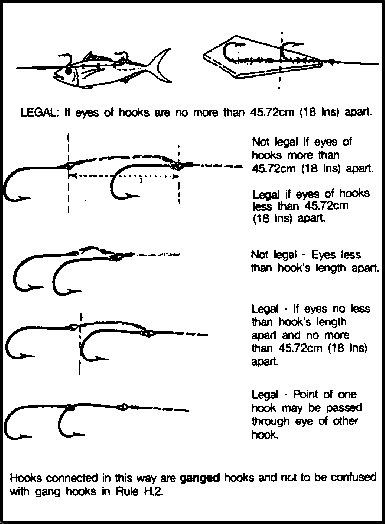
 Non IGFA
set
Non IGFA
set
The following picture is the preferred method for creating a loop to which either a hook can be added or preferably a small stainless steel shackle then the hook attached to this.
This system is exceptionally strong and will out perform a Flemish eye every time. In an emergency if no crimps are available the tag can be kept really long, about 4 inches or 10 cm and taped up, this will still hold big fish .
This set up can be performed on ALL multi strand cables of any size.
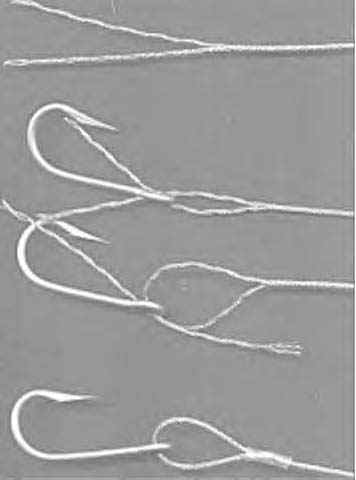
Cut off the insulation back about 15 cm or 6 or so inches and before you split the cable slide a crimp down the bare cable.
Now split the cable as per the diagram and continue.
The idea is to splice the cable back into itself to create a strong loop and then crimp the tag end to the main cable.
keep at it and good luck as it is one of the most important fundamental lessons in Not Losing big sharks, having strong LINKS
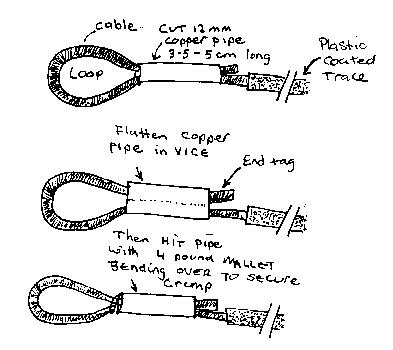
It is most important to properly crimp these traces as per the above diagram. In the case of 2mm traces you can use 500lb Jinkai crimps, for cable above this size I use copper piping 12mm etc cut into lengths of 1.5 inches I then place these in the vice and squash the pipe over the cable and then bend the flat copper pipe in half again and give it a good hit afterwards with a heavy 4lb hammer. This is done at the end of trace lengths to secure a loop properly.
For Floats on the trace to keep the bait at the desired depth I always use the Aquagem float system. They are hard wearing and never let me down... For more information on them click here.
Swivels and Shackles
Now this is a section you should pay attention to. I have never lost a rig to a faulty swivel, why ... because I ALWAYS use oversized material. I will give an example. You are fishing with 80lb line and want to make a trace so you go down to the tackle shop and buy a swivel that's rated at 200lb, great you think I have plenty to play with. WRONG..... you see when you are playing a fish every time it makes a run it pulls against your drag, not you... Now you have subdued this shark by the jetty and tie the trace off to a fixed structure, whilst you work out what to do next. Guess what...? the shark is no longer pulling against your drag but the jetty. now if it's a good shark all that pulling will stress the swivel and then pop it breaks off and you watch as the sharks swims off. Don't believe it, well it happens all the time as one unfortunate sharkie at Point Lonsdale just recently found out. Luckily he has caught a few more since then, but you might not be so lucky. Use the biggest ball bearing swivel you can find, preferably "Sampo's" 500lb should do it. Now do not attach the swivel anywhere except at the end where it joins the trace and fishing line, because if you do tie the trace off, you can attach it to the end of this rig, and you will not have any weak links in your system . You do not need heaps of swivels just one. If you are fishing for really serious sharks upwards of 250kg with the preferred 3.5mm - 4.0mm plastic coated cable then I would only consider using a stainless steel boating shackle, one with a closed end and the other end being a screwed pin type construction. Tie the line double to the closed loop end, this gives you the option to change traces if you need to They are not cheap about $10 each but I have never been let down on a huge shark, and its nice to have that confident feeling right through the trace. Take shortcuts and your shark will swim away not attached to your line. Its your choice...
Hooks
Hooks are hooks ,...... well aren't they ??? . You may think this until you see a 16/0 or 18/0 straightened. Vic Hislop makes his own 24/0 to 28/0 size hooks , they are big, expensive, and never let him down, but us mere mortals will probably just buy them. The ones I prefer are the good old Mustads 7699 offset pattern. They come in a good range from 12/0 (min size I use) to the good luck hold onto your arse were going water skiing 24/0 size. The most I use is 18/0 on 130lb gear with stingray baits, 16/0 are great for most 80lb set-ups, lage tunas, eels etc, I never use 14/0 but then step down to a 12/0 for small tuna bait. Remember this, you choose the hooks to suit the size of your bait - that's it. Small bait - small hook, big bait - . big hook, got it !!? Forget chemically sharpened hooks as they lose their tip too quick, Limerick hooks or similar are not good quality, stainless are to expensive, and straight hooks just don't set properly.
Next question, how do I sharpen a 16/0 - 18/0 hook ? Well I do it very gently with an angle grinder and a cutting disk, making sure not to use too much pressure and not to get the tip too hot. I can get an 18/0 as sharp as a chemically sharpened hook, how do I know this, just ask my poor finger !!!! Some people will tell you this damages the tip, well I have caught more big land based sharks then most people will ever catch, this is how I do ALL my hooks, and I have never had a problem, so who are you going to listen to, some know it all that would not know a shark hook from his arse !??. I leave this up to you.....
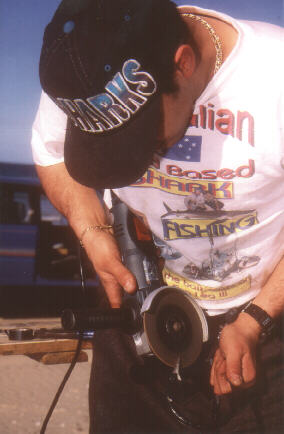
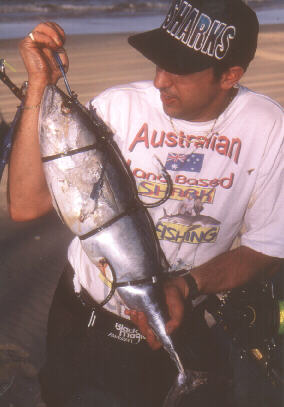
Always tape up your hooks with good quality electrical insulation tape as above, so that as little metal is exposed as possible, to help reduce electro magnetic fields in the water, and when you set them in the bait keep them proud of the bait never hide them too deep as you will miss too many hook ups. A really good idea that Vic Hislop taught me was to always cover the hook tips with animal tallow to stop them rusting in the water or lard if this is not available, especially if you are leaving the baits out for a couple of days. Vic also told me to sharpen the hooks after you have hooked them through the bait, to ensure maximum strike rate, over the top, maybe but I am not taking any chances - are you ?